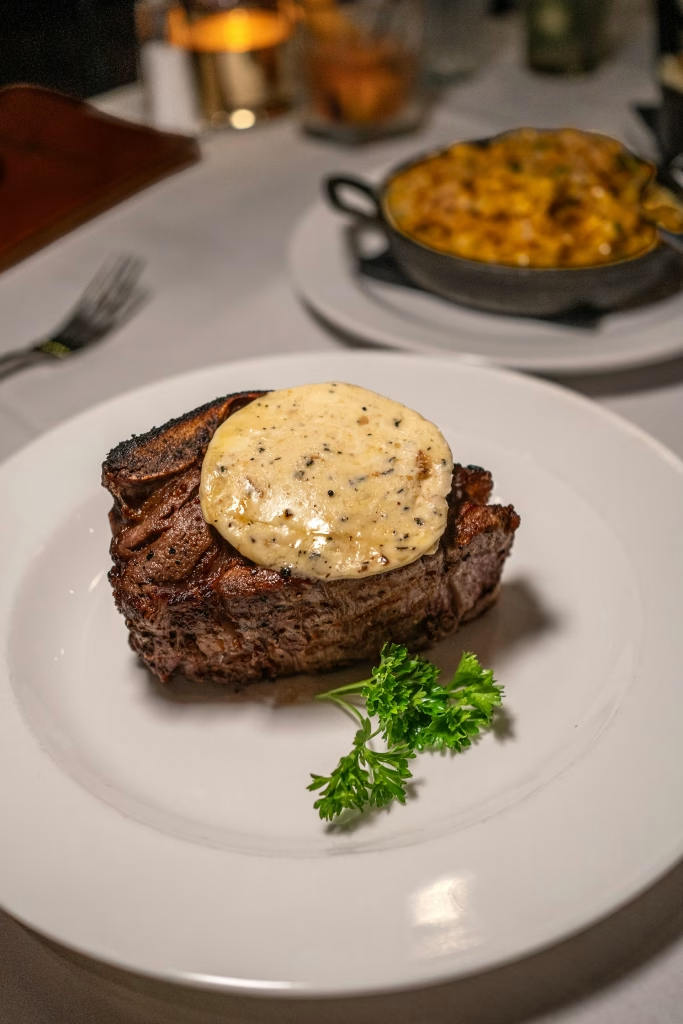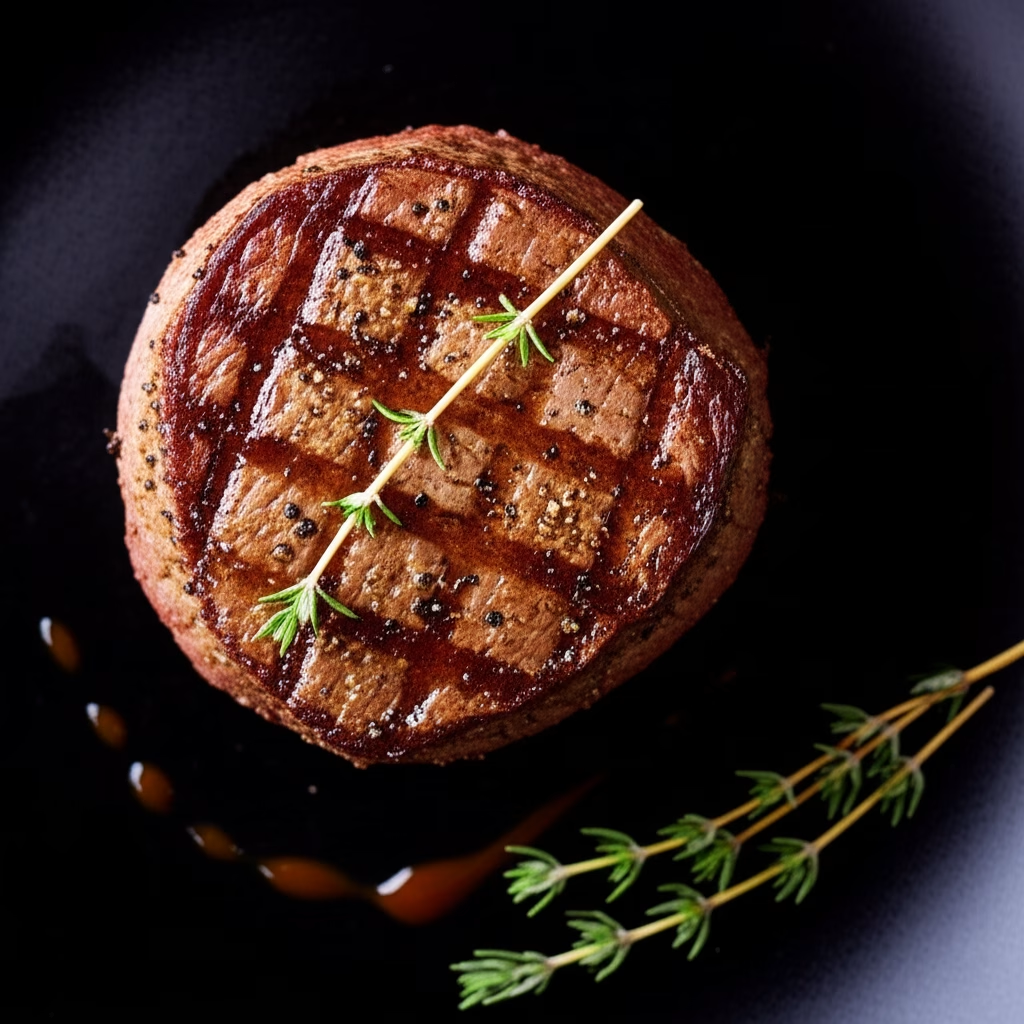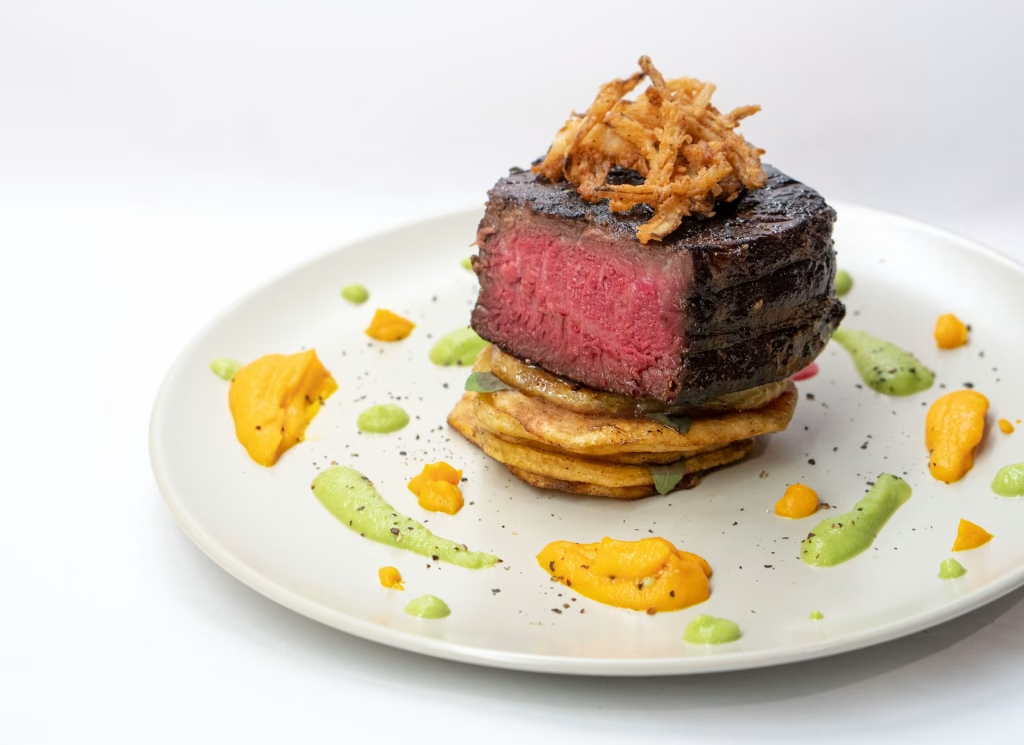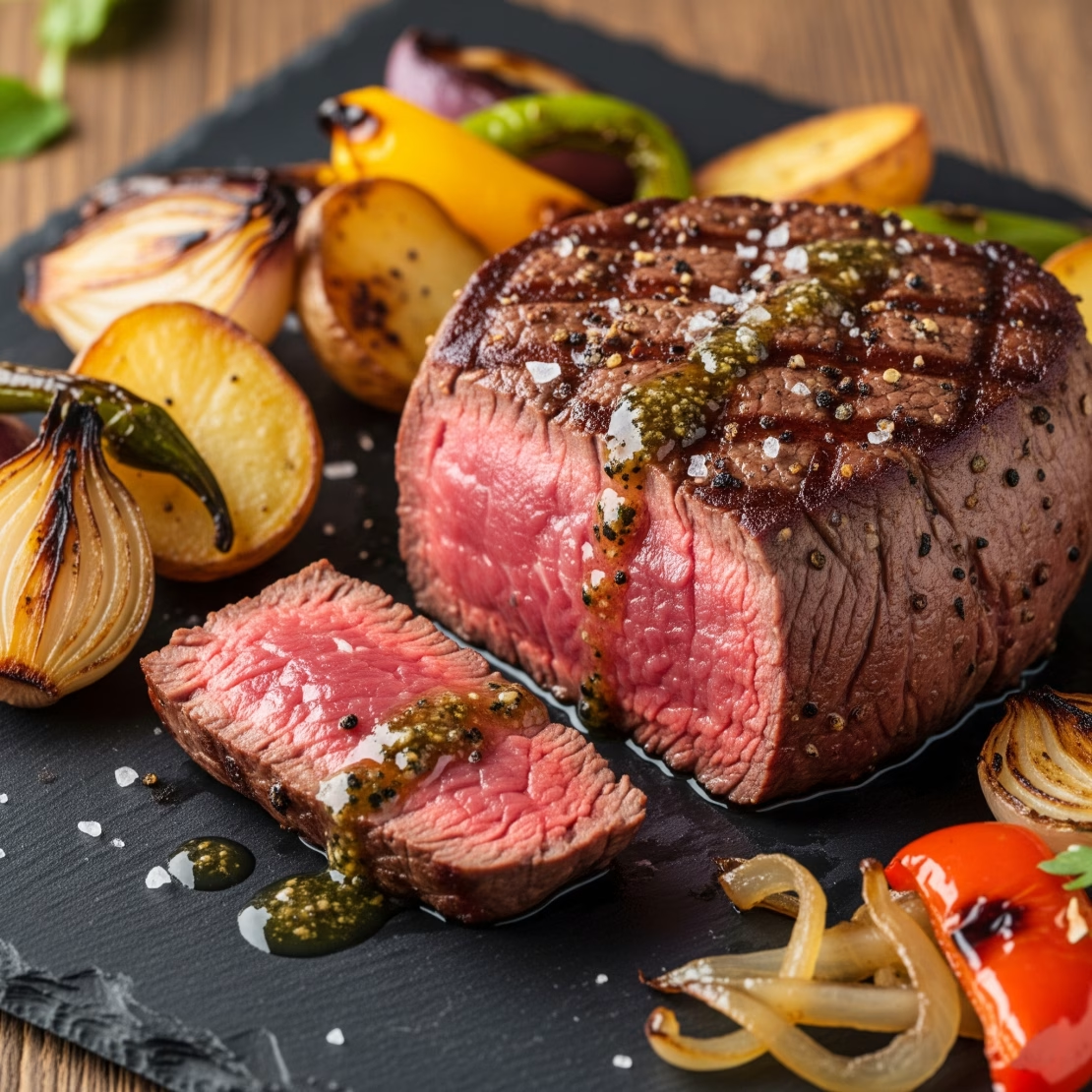Filet Mignon is a tender, buttery cut of beef from the smaller end of the tenderloin, prized for its melt-in-your-mouth texture and subtle flavor.
Known as the most luxurious steak, it’s often simply seasoned and seared to perfection, then finished in the oven or pan, making it a quintessential choice for fine dining and special occasions.
Table of Contents
Ingredients
- 2 filet mignon steaks (6-8 ounces each, about 1.5 to 2 inches thick)
- 2 tablespoons unsalted butter
- 2 tablespoons olive oil or vegetable oil
- 2 garlic cloves, smashed
- 2 sprigs fresh thyme or rosemary
- Salt, to taste
- Freshly ground black pepper, to taste
- Optional: 1/4 cup red wine or beef broth (for pan sauce)
Serves
2 servings
Step-by-Step Instructions
Step 1: Prepare the Steaks
- Remove filet mignon steaks from the refrigerator at least 30 minutes before cooking to bring to room temperature. This ensures even cooking.
- Pat steaks dry with paper towels to remove excess moisture.
- Generously season both sides with salt and freshly ground black pepper.
Step 2: Preheat the Pan
- Heat a heavy skillet or cast-iron pan over medium-high heat until very hot.
- Add olive oil and swirl to coat the pan.
Step 3: Sear the Steaks
- Place the steaks in the hot pan, leaving space between them.
- Sear without moving for about 3-4 minutes until a rich brown crust forms.
- Flip the steaks and add butter, smashed garlic cloves, and fresh herbs to the pan.
- Tilt the pan slightly and use a spoon to baste the steaks with the melted butter and herb-infused oil for 2-3 minutes.
Step 4: Finish Cooking
- Oven method:
Preheat the oven to 400°F (200°C). After searing, transfer the skillet to the oven and cook for 4-6 minutes for medium-rare, or longer depending on desired doneness. - Stovetop method:
Continue cooking on the stovetop, turning steaks every minute and basting, until desired doneness is reached.
Step 5: Check Doneness
Use an instant-read meat thermometer for accuracy:
- Rare: 120-125°F (49-52°C)
- Medium-rare: 130-135°F (54-57°C)
- Medium: 140-145°F (60-63°C)
- Medium-well: 150-155°F (66-68°C)
- Well done: 160°F+ (71°C+)
Step 6: Rest the Steaks
Remove steaks from heat and transfer to a plate. Tent loosely with foil and rest for 5-10 minutes to redistribute juices.
Step 7: Optional Pan Sauce
- Place the skillet back on medium heat.
- Add red wine or beef broth, scraping up browned bits.
- Simmer and reduce by half.
- Remove from heat and swirl in a tablespoon of butter.
- Pour sauce over steaks before serving.

Serving Suggestions
- Classic sides such as garlic mashed potatoes or roasted baby potatoes.
- Grilled or steamed asparagus, green beans, or sautéed mushrooms.
- A simple mixed greens salad with vinaigrette.
- Red wine reduction or Béarnaise sauce for extra decadence.
- Glass of full-bodied red wine like Cabernet Sauvignon or Merlot.
Tips for Perfect Filet Mignon
- Bring to room temperature: Ensures even cooking throughout.
- Pat steaks dry: Helps create a better crust.
- Use a hot pan: For proper searing and caramelization.
- Don’t overcrowd the pan: Sear steaks in batches if needed.
- Use a thermometer: Avoid guessing doneness.
- Let steaks rest: Retains moisture and flavor.
- Baste with butter and herbs: Adds richness and aroma.
- Avoid overcooking: Filet mignon is best medium-rare to medium.
- Use fresh herbs: Thyme or rosemary complement beef beautifully.
- Choose quality meat: USDA Prime or Choice for best flavor and tenderness.

Healthier Alternatives
- Substitute butter with olive oil or avocado oil for healthier fats.
- Skip pan sauce or use a light broth reduction instead of wine and butter.
- Serve with steamed or roasted vegetables instead of heavy potato sides.
- Use grass-fed beef for leaner, more nutrient-rich meat.
- Limit added salt, relying on fresh herbs and spices for flavor.
Creative Variations
- Bacon-wrapped filet mignon: Wrap steaks with bacon before searing for extra flavor.
- Stuffed filet: Slice a pocket and stuff with blue cheese or sautéed mushrooms.
- Peppercorn crust: Coat steaks with crushed peppercorns before searing.
- Garlic herb butter topping: Melted butter infused with garlic and herbs served over the steak.
- Filet mignon with red wine sauce: Make a rich sauce with shallots, wine, and stock.
- Filet with foie gras: Classic French pairing for indulgence.
- Grilled filet mignon: Cook on the grill for a smoky flavor.
- Surf and turf: Pair with lobster tail or shrimp.
- Filet mignon skewers: Cut into medallions and grill on skewers.
- Filet with mushroom ragout: Sauté mushrooms with herbs and serve on top.
Common Mistakes to Avoid
- Skipping resting time: Leads to juices running out and dry meat.
- Overcooking: Filet mignon becomes tough and loses tenderness.
- Using cold steaks: Causes uneven cooking.
- Not drying the meat: Prevents good crust formation.
- Using low heat: Won’t sear properly.
- Not seasoning enough: Filet mignon benefits from generous salt and pepper.
- Overcrowding the pan: Causes steaming instead of searing.
- Ignoring carryover cooking: Meat continues to cook after removed from heat.
- Using cheap cuts: Filet mignon is best when high quality.
- Not cleaning pan between batches: Burnt bits can affect flavor.
History of Filet Mignon
Filet mignon, French for “dainty fillet,” originates from the tenderloin cut of beef, one of the most tender and prized parts of the cow. The cut is favored for its buttery texture and mild flavor, which contrasts with the more robust beef cuts like ribeye or strip steak.

Its rise to culinary prominence is closely linked with French haute cuisine, where chefs prized it for both its tenderness and its elegance on the plate. By the 19th century, filet mignon became synonymous with refined dining, often paired with rich sauces and luxurious ingredients such as foie gras and truffles.
Today, filet mignon is one of the most sought-after steaks globally, representing the pinnacle of steakhouse dining. Despite its high cost, it remains a favorite for celebratory meals, prized for its melt-in-the-mouth quality and its simplicity that highlights the quality of the beef itself.
FAQs About Filet Mignon
- What is filet mignon?
A tender, lean cut from the smaller end of the beef tenderloin. - How do I cook filet mignon perfectly?
Sear in a hot pan, then finish in the oven or stovetop until medium-rare or desired doneness. - Is filet mignon better than ribeye?
They’re different: filet mignon is more tender but less flavorful, ribeye is fattier and more robust. - Can I grill filet mignon?
Yes, grilling imparts a smoky flavor, but watch carefully to avoid overcooking. - Should I season filet mignon before cooking?
Yes, salt and pepper enhance the natural beef flavor. - How thick should filet mignon steaks be?
Ideally 1.5 to 2 inches for even cooking. - What side dishes go well with filet mignon?
Mashed potatoes, sautéed vegetables, and a light salad. - Can I use frozen filet mignon?
It’s best fresh, but properly thawed frozen steaks can be used. - Why is filet mignon so expensive?
It’s a small, tender part of the cow with less marbling, making it rare and highly prized. - What wine pairs with filet mignon?
Full-bodied reds like Cabernet Sauvignon or Merlot.
Filet mignon stands as an iconic cut of beef, celebrated for its unparalleled tenderness and subtle flavor. Whether seared simply with butter and herbs or dressed up with rich sauces, this steak delivers a luxurious dining experience that’s accessible to home cooks willing to follow careful steps. Mastering filet mignon offers a gateway to fine dining at home, impressing guests with every juicy, melt-in-your-mouth bite. With proper preparation, seasoning, and resting, filet mignon is sure to become a timeless favorite on your dinner table.


